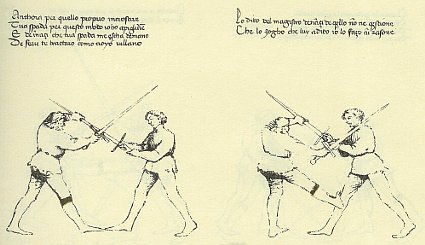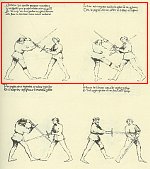
| Fiore dei Liberi: Flos Duellatorum, 1410 (Pisani-Dossi, F. Novati, Bergamo, 1902) |
| 4 spada longa - longsword |
| 4.2 gioco sença arme (unarmoured plays) |
| 4.2.3 gioco largo in incrosar a pigliare (long play with a crossing and taking hold of the sword) |
| Anchora per quello proprio incrosare Tua spada per questo modo io ho a pigliare E de inançi che tua spada me escha de mano De ferir te tractarò como croyo uillano Lo dito del magistro denançi de quello non n'e questione |
| Also for this particular crossing I am able to take hold of your sword in this manner And from before that your sword is food for my hand Of striking you vigorously to a staggering villain There is no question of what the previous master had said |
Synopsis:  This pair of illustrations continue on a the concept of crossing of the swords, in which the crossing is made but the action is momentarily stopped which precipitates the action described. The first four lines sets the stage for the snatching by the hand by specifying in the first line a particular crossing which is conducive to making a grab. Note that in the illustration, the scholler's hilt is against the blade creating a incrosar a meça spada, whereby, the scholler's sword is crossed at the hilt against the middle of the zugadore's sword. Fiore somewhat sarcastically states that a sword in this position (static and crossed at the hilt) makes for an opportunity for the grab ("food for the hand" - of course, the translation can be entirely incorrect!), creating the opportunity to strike against the "staggering villain" or zugadore and delivering a strike which incapacitates the zugadore.
This pair of illustrations continue on a the concept of crossing of the swords, in which the crossing is made but the action is momentarily stopped which precipitates the action described. The first four lines sets the stage for the snatching by the hand by specifying in the first line a particular crossing which is conducive to making a grab. Note that in the illustration, the scholler's hilt is against the blade creating a incrosar a meça spada, whereby, the scholler's sword is crossed at the hilt against the middle of the zugadore's sword. Fiore somewhat sarcastically states that a sword in this position (static and crossed at the hilt) makes for an opportunity for the grab ("food for the hand" - of course, the translation can be entirely incorrect!), creating the opportunity to strike against the "staggering villain" or zugadore and delivering a strike which incapacitates the zugadore.
The second couplet really doesn't add anything to the message Fiore is conveying here, except that the possible suggestion may be to have the "intestinal fortitude" that while grabbing the zugadore's sword, the scholar (wearing the garter below the right knee) strikes the zugadore's right knee with the scholar's right foot. This may appear a dangerous maneauvre however, provided the scholar has the opportunity created by grabbing the sword, the scholar must not waiver from the intent of incapacitating the zugadore by striking the knee.
Practical Application: The execution of this technique is extremely dependent upon timing and the situation which will allow this to materialize. Once the blades are crossed and are static in space, the scholler (wearing the garter below the right knee) is able to grab hold of the blade, releasing the bind and while striking the zugadore, pulls him towards him and kicks the right knee of the zugadore. In order to achieve proper distance (closing in), the scholler takes a step in as does the zugadore for his delivery of the strike, creates a bind and executes the technique described. This can be executed from being in-line with the zugadore towards his outside. Any cross which occurs within the zugadore's "inside" would be far more difficult to execute, if at all.
| Fiore de' Liberi | 1410 | incroso e entro el fiero li chogiun (crossing and entering and striking the genitals) |